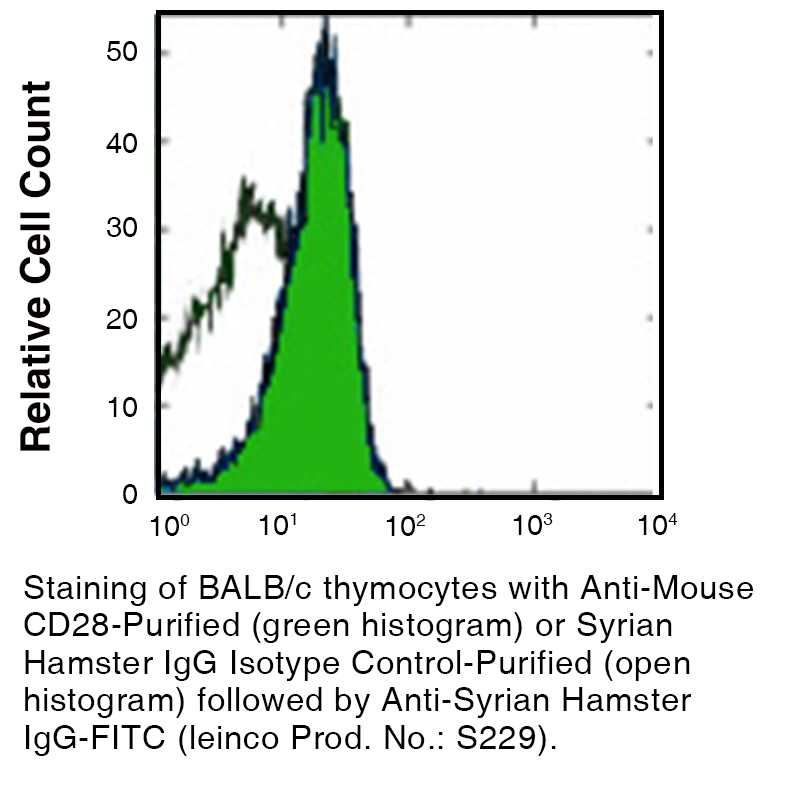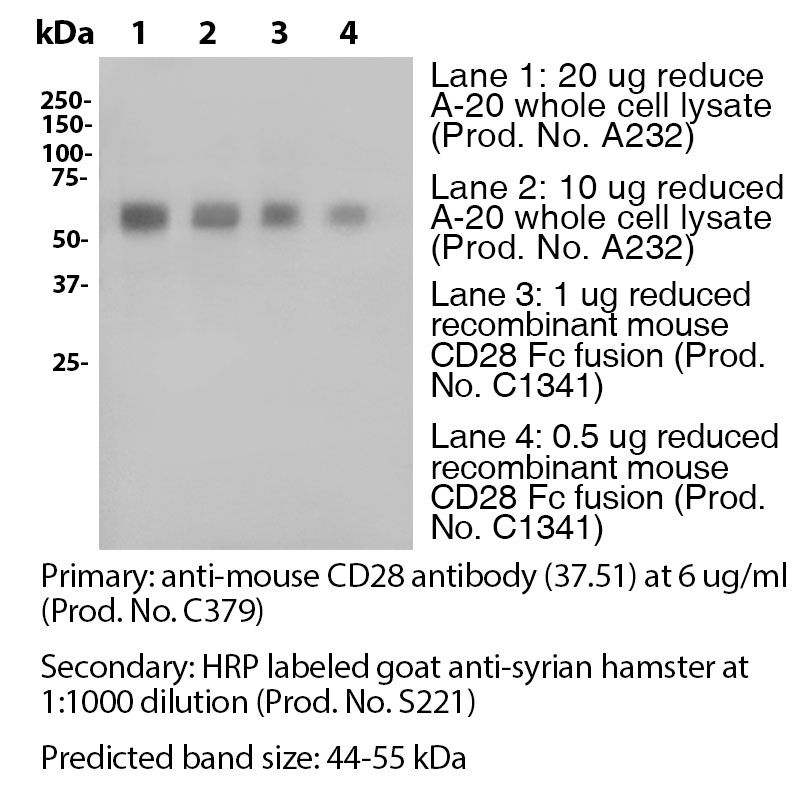Anti-Mouse CD28 [Clone 37.51] — Purified in vivo GOLD™ Functional Grade
Anti-Mouse CD28 [Clone 37.51] — Purified in vivo GOLD™ Functional Grade
Product No.: C379
Clone 37.51 Target CD28 Formats AvailableView All Product Type Monoclonal Antibody Alternate Names MGC138290, Tp44, T44 Isotype IgG Applications B , Costim , CyTOF® , FA , FC , IHC FF , in vivo , IP , WB |
Data
Antibody DetailsProduct DetailsReactive Species Mouse Host Species Syrian Hamster Recommended Isotype Controls Syrian Hamster IgG Recommended Dilution Buffer Immunogen C57BL/6 mouse T-cell lymphoma EL-4 Product Concentration ≥ 5.0 mg/ml Endotoxin Level < 1.0 EU/mg as determined by the LAL method Purity ≥95% monomer by analytical SEC ⋅ >95% by SDS Page Formulation This monoclonal antibody is aseptically packaged and formulated in 20 mM L-histidine and 150 mM NaCl buffer, pH 5.9-6.1 with no carrier protein, potassium, calcium or preservatives added. Due to inherent biochemical properties of antibodies, certain products may be prone to precipitation over time. Precipitation may be removed by aseptic centrifugation and/or filtration. Product Preparation Functional grade preclinical antibodies are manufactured in an animal free facility using in vitro cell culture techniques and are purified by a multi-step process including the use of protein A or G to assure extremely low levels of endotoxins, leachable protein A or aggregates. Storage and Handling Functional grade preclinical antibodies may be stored sterile as received at 2-8°C for up to one month. For longer term storage, aseptically aliquot in working volumes without diluting and store at ≤ -70°C. Avoid Repeated Freeze Thaw Cycles. Country of Origin USA Shipping Next Day 2-8°C RRIDAB_2737482 Applications and Recommended Usage? Quality Tested by Leinco FC The suggested concentration for this 37.51 antibody for staining cells in flow cytometry is ≤ 1.0 μg per 106 cells in a volume of 100 μl. Titration of the reagent is recommended for optimal performance for each application. WB The suggested concentration for this 37.51 antibody for use in western blotting is 1-10 μg/ml. Additional Applications Reported In Literature ? CyTOF® IHC (Frozen) B Cosim IP Each investigator should determine their own optimal working dilution for specific applications. See directions on lot specific datasheets, as information may periodically change. DescriptionDescriptionSpecificity Clone 37.51 recognizes an epitope on mouse CD28. Background CD28 is a 44 kD glycoprotein and a member of the Ig superfamily. In its capacity as a costimulatory receptor, CD28 produces co-stimulatory signals necessary for T cell activation and survival. CD28 is the only B7 receptor constitutively expressed on naive T cells. Without having this CD28/B7 interaction, T cells will fail to respond to their specific antigen when coming in contact with an MHC/antigen complex and thus, are said to be anergic. Antigen Distribution CD28 is expressed on thymocytes, CD4+, CD8+ peripheral T cells, NK cells. Ligand/Receptor CD80 (B7-1), CD86 (B7-2) Function Costimulates T and NK cells PubMed NCBI Gene Bank ID UniProt.org Research Area Costimulatory Molecules . Immunology Leinco Antibody AdvisorPowered by AI: AI is experimental and still learning how to provide the best assistance. It may occasionally generate incorrect or incomplete responses. Please do not rely solely on its recommendations when making purchasing decisions or designing experiments. Clone 37.51 is most commonly used in vivo in mice to provide CD28-mediated costimulation, which augments T cell activation, proliferation, and cytokine (notably IL-2) production; it is also applied to block CD28 signaling to study immune modulation and tolerance. Key in vivo applications include:
These applications are supported by the antibody's strong binding specificity for mouse CD28 and its ability to reliably modulate immune responses in vivo as well as in vitro. The 37.51 antibody targets mouse CD28, a key costimulatory molecule on T cells. In immunological assays and experimental protocols, 37.51 is almost always used alongside other antibodies or proteins that define immune cell populations or modulate T cell activation. Within the literature, some of the most commonly used antibodies or proteins in combination with 37.51 include:
Key references from manufacturers and reagent suppliers confirm that applications almost always involve:
In summary, anti-CD3 is the most frequent partner for 37.51 (anti-CD28), with additional typical antibodies including anti-CD4, anti-CD8, anti-CD25, anti-CD69, and sometimes NK1.1 and cytokine-specific antibodies depending on the experimental context. The monoclonal antibody clone 37.51 targets the mouse CD28 molecule, a 45 kDa homodimer expressed on thymocytes, mature T cells, and NK cells. CD28 is a potent costimulator of T cells, interacting with CD80 (B7-1) and CD86 (B7-2) to enhance T cell activation and cytokine production. Key findings from scientific literature using clone 37.51 include:
Overall, clone 37.51 is a versatile tool in immunology research, facilitating the study of T cell biology and immune responses. Dosing regimens of clone 37.51 (anti-mouse CD28 antibody) vary significantly across mouse models, primarily depending on dose, frequency, route of administration, and purpose. Different studies and vendors report variations, with doses ranging from less than 0.5 μg per sample for flow cytometry to 10–30 μg per injection in in vivo therapeutic experiments. Essential Context and Supporting Details
Additional Relevant Information
In summary:
References & Citations1. Gallimore, A. et al. (2005) J Immunol. 175(11):7098-102. PubMed 2. Gross, J. A. et al. (1992) J. Immunol. 149:380 Technical ProtocolsCertificate of Analysis |
Related Products
Prod No. | Description |
|---|---|
S211 | |
R1364 | |
C247 | |
F1175 | |
S225 | |
A132 | |
S571 |
Formats Available
Prod No. | Description |
|---|---|
C1706 | |
C1707 | |
C1709 | |
C243 | |
C244 | |
C246 | |
C1701 | |
C1702 | |
C1703 | |
C1705 | |
C347 | |
C379 | |
C1658 |
 Products are for research use only. Not for use in diagnostic or therapeutic procedures.
Products are for research use only. Not for use in diagnostic or therapeutic procedures.




